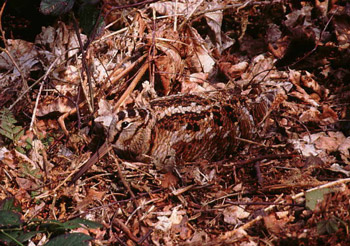
We urgently need to monitor changes in breeding Woodcock numbers, given the recent population decline. Please do consider re-surveying your square or another site in 2018 and help us monitor this declining species. Please register or login using the buttons on the left to request a square or submit your 2018 counts.
Full results have been published for the 2013 breeding Woodcock survey (PDF), which estimated a population of 55,241 males, representing a decline of 29% since 2003. Summary details can be found on the Results page.
Woodcock is the only species of wading bird in Britain and Ireland that is adapted to breed in woodland, both broad-leaved and coniferous. Its plumage is superbly camouflaged to blend in with dead leaf litter and ground vegetation, where it may roost or make its nest; remaining motionless unless approached at very close quarters.
The breeding distribution covers much of Britain and Ireland, however, a considerable reduction in range has been indicated by the 2008-11 Breeding Atlas, since the 1968-72 Breeding Atlas (Sharrock 1976) and a reduction in abundance, as shown by the results of
annual roding counts between 2003 and 2012 (PDF, 390.23 KB)
. In 2015, it was upgraded to Red listed (previously Amber listed) as a bird of conservation concern, due to the decline in breeding numbers and range.
The nocturnal habits and cryptic nature of this species makes it difficult to monitor the breeding population using our traditional survey methods, such as the Breeding Bird Survey (BBS). However, a
special survey method for Woodcock (PDF, 96.91 KB)
has been devised, which uses the counts of the territorial roding flights, undertaken by males at dusk and dawn, to estimate the number of individual males present.
The first
breeding Woodcock Survey was undertaken in 2003 (PDF, 278.53 KB)
estimated a breeding population of 78,000 males in Britain. Thus providing a baseline against which to assess future population change. During winter, it is estimated that up to 1.5 million individuals may be present in Britain and Ireland; mostly originating from northern Europe and western Russia.
The results of the annual breeding season counts run by BTO and GWCT, will be crucial for monitoring future changes to the breeding population.
No comments:
Post a Comment